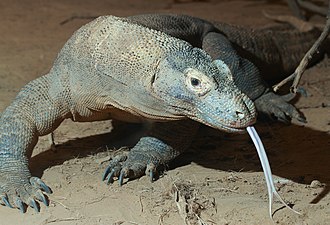The Komodo dragon (Varanus komodoensis), also known as the Komodo monitor, is a member of the monitor lizard family Varanidae that is endemic to the Indonesian islands of Komodo, Rinca, Flores, and Gili Motang. It is the largest extant species of lizard, growing to a maximum length of 3 metres (10 ft), and weighing up to approximately 70 kilograms (150 lb).
Komodo dragons were first documented by Europeans in 1910, when rumors of a "land crocodile" reached Lieutenant van Steyn van Hensbroek of the Dutch colonial administration. Widespread notoriety came after 1912, when Peter Ouwens, the director of the Zoological Museum of Bogor, Java, published a paper on the topic after receiving a photo and a skin from the lieutenant, as well as two other specimens from a collector.[4]
The first two live Komodo dragons to arrive in Europe were exhibited in the Reptile House at London Zoo when it opened in 1927. Joan Beauchamp Procter made some of the earliest observations of these animals in captivity and she demonstrated their behaviour at a Scientific Meeting of the Zoological Society of London in 1928.
The Komodo dragon was the driving factor for an expedition to Komodo Island by W. Douglas Burden in 1926. After returning with 12 preserved specimens and two live ones, this expedition provided the inspiration for the 1933 movie King Kong. It was also Burden who coined the common name "Komodo dragon." Three of his specimens were stuffed and are still on display in the American Museum of Natural History.
The evolutionary development of the Komodo dragon started with the genus Varanus, which originated in Asia about 40 million years ago and migrated to Australia, where it evolved into giant forms (the largest of all being the recently extinct Megalania), helped by the absence of competing placental carnivorans. Around 15 million years ago, a collision between the continental landmasses of Australia and Southeast Asia allowed these larger varanids to move back into what is now the Indonesian archipelago, extending their range as far east as the island of Timor.
The Komodo dragon is believed to have differentiated from its Australian ancestors about 4 million years ago. However, fossil evidence from Queensland suggests the Komodo dragon actually evolved in Australia, before spreading to Indonesia.
Dramatic lowering of sea level during the last glacial period uncovered extensive stretches of continental shelf that the Komodo dragon colonised, becoming isolated in their present island range as sea levels rose afterwards. Fossils of extinct Pliocene species of similar size to the modern Komodo dragon, such as Varanus sivalensis, have been found in Eurasia as well, indicating that they fared well even in environments containing competition, such as mammalian carnivores, until the climate change and extinction events that marked the beginning of the Pleistocene.
In the wild, adult Komodo dragons usually weigh around 70 kg (150 lb), although captive specimens often weigh more. According to Guinness World Records, an average adult male will weigh 79 to 91 kg (174 to 201 lb) and measure 2.59 m (8.5 ft), while an average female will weigh 68 to 73 kg (150 to 161 lb) and measure 2.29 m (7.5 ft). The largest verified specimen in captive was 3.13 m (10.3 ft) long and weighed 166 kg (366 lb), including its undigested food. The largest wild specimen had a length 3.04 m (10.0 ft), a snout-vent length (SVL) 1.54 m (5 ft 1 in) and a mass of 81.5 kg (180 lb) excluding stomach contents. The heaviest reached a mass in 87.4 kg (193 lb). The study noted that weights greater than 100 kg (220 lb) were possible but only after the animal had consumed a large meal.
Komodo dragons are apex predators. They are carnivores; although they have been considered as eating mostly carrion, they will frequently ambush live prey with a stealthy approach. When suitable prey arrives near a dragon's ambush site, it will suddenly charge at the animal at high speeds and go for the underside or the throat.
Komodo dragons do not deliberately allow the prey to escape with fatal injuries but try to kill prey outright using a combination of lacerating damage and blood loss. They have been recorded as killing wild pigs within seconds, and observations of Komodo dragons tracking prey for long distances are likely misinterpreted cases of prey escaping an attack before succumbing to infection.
Komodo dragons eat by tearing large chunks of flesh and swallowing them whole while holding the carcass down with their forelegs. For smaller prey up to the size of a goat, their loosely articulated jaws, flexible skulls, and expandable stomachs allow them to swallow prey whole. The undigested vegetable contents of a prey animal's stomach and intestines are typically avoided. Copious amounts of red saliva the Komodo dragons produce help to lubricate the food, but swallowing is still a long process (15–20 minutes to swallow a goat). A Komodo dragon may attempt to speed up the process by ramming the carcass against a tree to force it down its throat, sometimes ramming so forcefully that the tree is knocked down. A small tube under the tongue that connects to the lungs allows it to breathe while swallowing.
